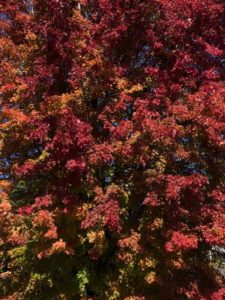 I have a friend that just came back from a road trip, taking the back roads through the western part of the state to catch some fall foliage along the Mississippi River.
I have a friend that just came back from a road trip, taking the back roads through the western part of the state to catch some fall foliage along the Mississippi River.
I know that taking a fall colors road trip is a popular and easy escape for people who live on the east coast as well.
Anywhere there is a tree, a deciduous tree, in an area which sees seasonal changes, in October, people are treated to a spectacular show.
Ahhhhhh.
Whether standing alone or in a park, preserve, or casting a reflected image in a mostly still tributary, feeling the end of summer and the beginning of winter seems to be condensed in this one image. At this time of year, red replaces green in the treetops.
We pay extra attention in anticipation of the trees shedding their defining trait, before their branches go bare.
There ought to be a name…
For this particular shade of red.
I think of many different names for shades of red lipstick.
Ruby, Cranberry, Hot Sauce, Majestic, Rouge Forever, Uncensored, Orange-red, Bad-ass…
A perfect name for the red leaves of October would not just be about hue. If there was a name, it would need to capture the feeling of richness, of time standing still while capturing a respect for all the changes that led up to this moment.
It seems essential, when taking in this sight, to acknowledge that this tree will not look exactly the same tomorrow.
I know that there are scientific reasons why the leaves on some trees turn red in the fall. It has to do with temperature and amount sunlight, species and sugar content. Maples and some varieties of oak, like Shumard, tend to take on fiery tones in October.
But I think my delight in seeing the leaves of a tree turning red goes beyond the color itself.
There ought to be a name.
In Illinois, where I live, leaves on more trees turn yellow or orange than they do red. I like the idea that their occurrence in nature, to take on a crimson glow, is rarer but not singular.
The conditions have to be right for this transformation to take place, and for the transformation to get noticed. You need sunlight and cool, but not freezing, temperatures. Most importantly — you have to be there to observe the transformation.
You need to have an appreciation for contrast.
Maybe I am more aware of the stationary parade of red leaves because they are seen against a blue sky. Maybe they make a bigger impression on me than yellow leaves because they appear less frequently. Or maybe, I consciously etch the image in my mind because I know their boldness and fragility won’t last.
In looking into a maple whose leaves are turning red, I can experience the beauty of impermanence.
The saturation of red, worn like a halo around the edges of unfurled branches, is captivating. I can peer past this outer layer and look at the still-green leaves closer to the trunk.
I can think about how the saturation of pigment will change over a matter of days and weeks, how the tree won’t look the same from one day to the next; how the tree is not more or less beautiful animated by different shades. Its beauty will just be different.
There ought to be a name.
Not just for the particular shade of red I see today but for the beauty of impermanence.
And isn’t this the way we celebrate life itself?
Committing to being in the moment, and cherishing whatever beauty it contains, is no small thing.


Leave a comment